Tōkyō’s Non-Freight Lines
A freight only branch is typically translated to English as a “Cargo Line”. There are a number of these scattered around the Tōkyō metropolitan area, either because they serve industrial areas with no significant passenger demand, or because they provide bypass connections between dual-use lines to handle different traffic patterns for freight. But there are also a few former freight lines, still referred to as Freight or Cargo lines, which remain in service for other purposes, but no longer appear to carry freight trains. The two I have run across so far are the Etchūjima Cargo Line and the Sōbu Freight Branch Line, which together provide a north-south link on the east side of Tōkyō, from the waterfront to the Jōban line, that is used by maintenance-of-way trains, and apparently by nothing else.
Etchūjima Cargo Line and Related Lines and Stations
The Etchūjima Cargo Line, also known as the Etchūjima Freight-traffic Line (越中島貨物線) or the Etchūjima Branch Line (越中島支線) is a non-electrified single-track freight-only line from Koiwa on the Sōbu line to Etchūjima (also romanized as Ettyuuzima) Freight Station in Shiohama (2-chome Shiohama-ku Kōtō-ku, Tokyo 18-3). JR Freight (JRF) is a type II operator of the branch, which JR East apparently owns, since the privatization of JNR in April 1987. It isn’t actually a freight line any more, being used today only by maintenance of way trains.
The line originates at the Shin-Koiwasou marshaling yard, in Koiwa, and today terminates at a yard on the artificial island of Shiohama known as the Etchūjima Freight Station despite not being on Etchūjima island. It originally extended beyond Shiohama to Etchūjima and another artificial island, serving industries that have now been largely replaced by residential complexes.
The yard at Shin-Koiwasou is electrified, and connects to both the Sōbu Rapid line and a single-track electrified line that curves to the north, the Sōbu Cargo line (Japanese name uncertain). There is also a connection at Shiohama to the Keiyō line.
The line runs 11.7 km measured from the origin at Koiwa, including 2.3 km where it runs parallel (but without a connection) to the Sōbu Rapid line between Kameido and Koiwa. Although the line is single-track, there are vestiges along many sections that suggest it was formerly double-track.
At Kameido the line crosses over both the Sōbu Rapid Line and the Sōbu line on a bridge, and runs adjacent to and south of the station, before crossing the street (also on a bridge) and turning south.
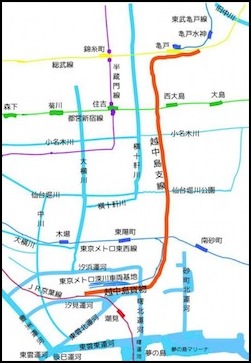
Etchūjima Cargo Line (red line) from Kameido to Shiohama (2009)
Location: Kōtō Ward, Tōkyō; Creator: Nzrst1jx
From there it runs 9.4 km south to the freight station in Shiohama. The northern part is elevated above adjacent roads, but it eventually descends to cross streets at grade.
There are no spurs or stations along the line, although there is a double-ended passing siding at the midpoint of the north-south section, adjacent to what was once a rail yard (the former Onagigawa Station, 小名木川駅), but is now just a dirt field. As of early 2010 Google Earth shows a DE10 and a string of cars on the siding.
A label on wikimapia.org identifies the former rail yard as "JR Onagigawa Freight Station". In 1999 Yomiuri Shimbun/Daily Yomiuri reported that JRF was looking for proposals from the private sector to redevelop the land of that station, due to a decline in traffic. The name is taken from the adjacent canal, known as the Onagi River (Onagigawa).
The branch crosses three canals, one of which is largely filled in, but still has water where the track crosses. Several bridges are sized for double-track, although in other places only single bridges exist. The line does not appear to have ever been double-tracked.
It would seem that the only remaining trains on the line are JR East maintenance trains, carrying welded rail sections from the yard in Shiohama, where it appears the rails are delivered by ship and assembled into longer lengths before being loaded on strings of flat cars rigged with frames to carry them. A few small switchers work the yard, and DE10 locomotives appear to be the usual motive power on the maintenance trains.
If you google using the Japanese form of the name for the branch line (越中島貨物線 or 越中島支線) you can find additional photos and videos, including this one showing a rail-handling train passing Kameido station.
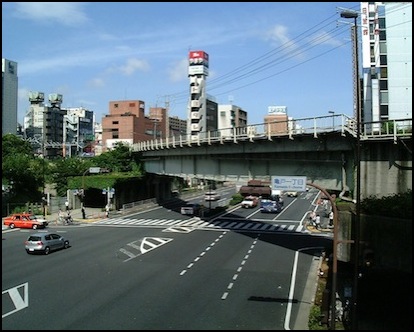
Etchūjima Line at Kameido Station Crossing Route 14 (2009)
Location: Kameido, Kōtō Ward, Tōkyō; Photographer: Nzrst1jx
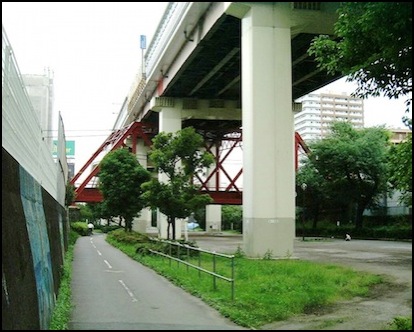
Etchūjima Line bridge below Highway #7 (2009)
Location: Nishiōjima, Kōtō Ward, Tōkyō; Photographer: Nzrst1jx
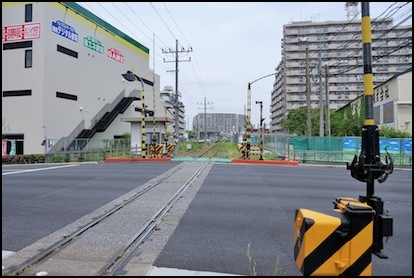
Etchūjima Line crossing Kasai-bashi-dori, route 475 (2009)
Location: Minami-suna,Kōtō Ward, Tōkyō; Photographer: ykanazawa1999
Sōbu Freight Branch Line
This is an electrified single-track line, the “shinkinkamotsusen”, 新金貨物線, “Shinkin Freight Line”, which seems to be referred to in places as the “Sōbu freight branch line” or “Cargo Branch Sōbu” and is translated as New Gold Line or New Money Line. It heads north from the east end of the Etchūjima Cargo Line (they meet at Shin-Koiwa Station, see below). It is apparently operated (or was operated) by both JR East and JR Freight (per the Japanese wikipedia page cited in the References section). It’s a single track line, but apparently was laid out with space for a second line (or perhaps it had one in the past, although if so, there’s no trace now, just abutments and bridges wide enough for two tracks). It may have been used to serve a Mitsubishi paper mill located just north of Kanamachi station (which had a rail siding, now removed).
Googling for the Japanese name will turn up some videos, including this one, shot from a passenger excursion from the south end at Shin-Koiwa to the north end (unfortunately the camera was pointed out the side window the entire time). There’s also a Japanese website that seems to be advocating turning it into a passenger line with a mid-point station (some of the sub-pages have some good photos of the line) and another Japanese website that’s a walking tour of the line (and apparently the source of some of the images on the other page), which shows some freight trains. Other information (see Shin-Koiwa Station description below) suggests regular freight use ended in 1997. However, the one photo I could find with a creative commons-compatible license was the one from the Japanese wikipedia page, which shows a freight on the line in 2009, crossing the distinctive spillway bridge, so perhaps it does still see some use.
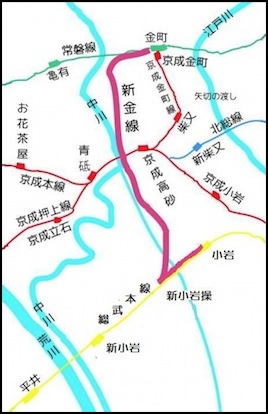
Sōbu Cargo Line (red line) (2009)
Location: Katsushika Ward, Tōkyō; Creator: Nzrst1jx, modified by Kone
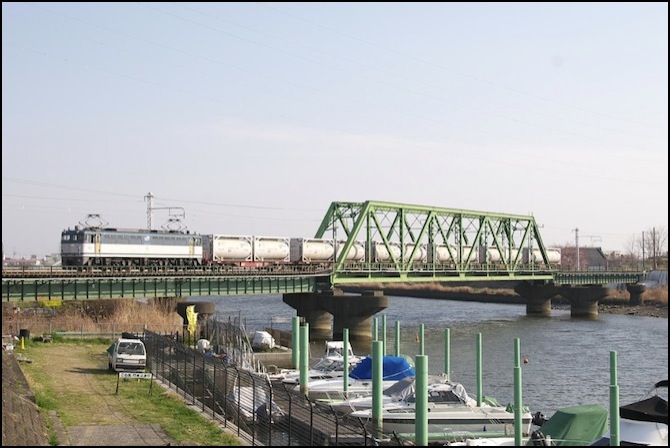
JR Freight on JRE Shinkin Freight Line (2009)
Location: Nakagawa Spillway, Nishikoiwa, Edogawa Ward, Tōkyō; Photographer: Rs1421
Shin-KoiwaSou Station
Information is hard to get, but this station appears to have abolished as a freight station in 1997 (25 August 1997), and now handles only ballast and rail trains for JR. This occurred when freight traffic was shifted off the Sōbu line to the Keiyō line.
It lies alongside and connected to the Sōbu line, just east of Shin-Koiwa station. From here an electrified single-track line heads north (the “shinkinkamotsusen”, which seems to be referred to in places as the “Sōbu freight branch line” or “Cargo Branch Sōbu”), and the Etchūjima Cargo Line heads west.
The Sōbu freight branch line is an electrified freight-only line that runs north to join the Jōban line at Kanamachi station, about 6.6km away.
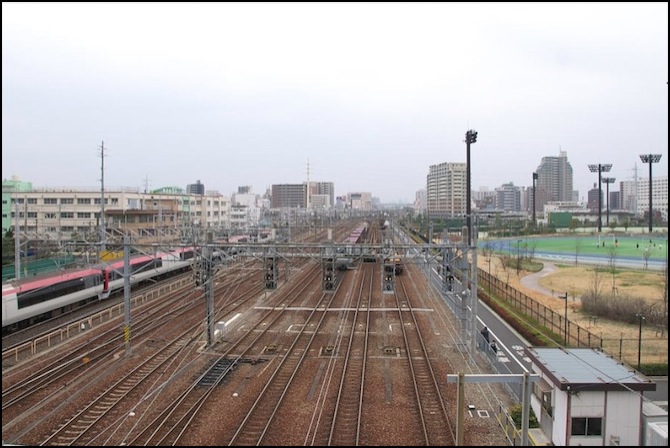
Shin-KoiwaSou Station with a Narita Express passing on the Sōbu line (2009)
Location: Katsushika City, Tōkyō; Photographer: Rs1421
Etchūjima Freight Station
The dockside freight station at the southern terminus, despite being located in Shiohama, was named Etchūjima Station until 1990, when the Keiyō line opened a station in Etchūjima, which took the name. After that, it was known as Etchūjima Freight Station.
The freight station is connected to both the Etchūjima branch line and the Keiyō line, between Etchūjima and Shiomi stations, although a train would need to reverse twice to move between the lines. The freight station is also adjacent, but not connected, to the Tokyo Metro Fukugawa maintenance facility.
The station is equipped with cranes for moving material from rail to vehicle or rail to ground, as well as one for transloading equipment from docked ships on the Shiomi canal to rail. In satellite views the water adjacent to that bank appears to have been dredged to allow ships to dock there.
In photos (below, and Google Earth overhead views) a number of small two-axle switchers can be seen working the freight station, although DE10 (five axle) locomotives seem to be used for trains to and from the facility. The two-axle units are known as “wagon movement machines” (貨車移動機) if they lack number plates, and typically restricted to yard work according to the Japanese wikipedia page cited below. I’ve seen pictures of others like this with number plates designating them as “DB” (diesel, two-axle) class locomotives.
The freight station opened in 1958, although the line existed in part from 1929, and appears to have closed in 1997. The line may have remained in use for a time after that, as there is a reference to a 2 Dec 2000 abolishment of Kikawa station (likely a variant of Onagigawa) on the line. The line was reopened (apparently for JR maintenance of way use) 10 November 2007.
I have seen a reference to the closure of a chemical plant on the line in 1997, which may have triggered the closure of the freight station, but details are lacking.
Videos and photos online as of early 2009 show it being used for what appear to be maintenance-of-way trains carrying bulk rail, ballast hoppers, and open hoppers, universally pulled by DE10 diesel locomotives, and the freight station appears to be being used to stockpile rail.
Some comments on a Japanese site suggest that the station is now used to assemble rail segments into longer welded rail lengths for JR East.
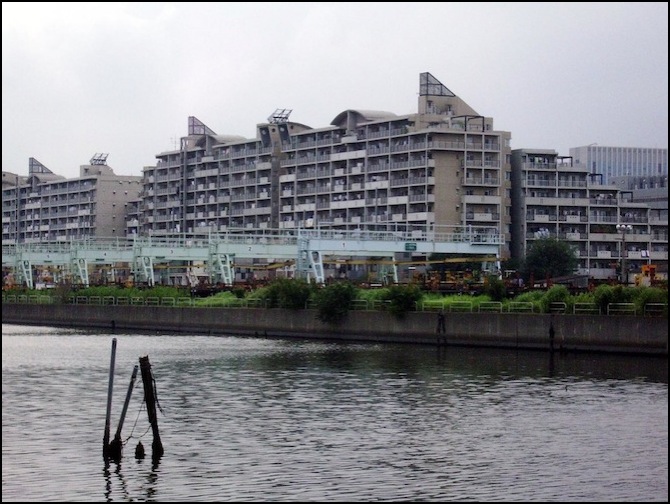
Etchūjima Freight Station, looking north-west (2009)
Location: Shiohama, Kōtō ward, Tōkyō; Photographer: Nzrst1Jx
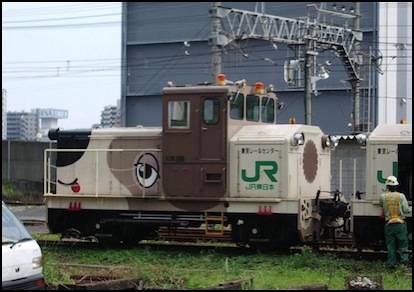
Etchūjima Freight Station switcher (“Convex B locomotive form”, 凸B形機関車) (2009)
Location: Shiohama, Kōtō ward, Tōkyō; Photographer: Nzrst1Jx
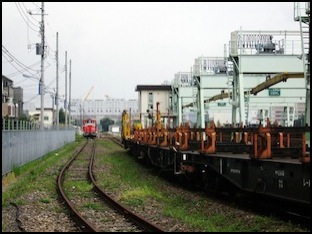
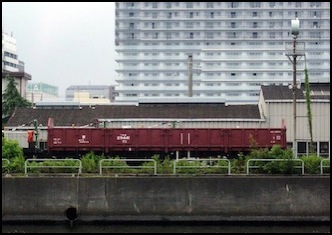
Etchūjima Freight Station north side, looking east, with DE10 and flat cars rigged for transporting rail and (right) O-TOKI Gondola (Both 2009)
Location: Shiohama, Kōtō ward, Tōkyō; Photographer (both): Nzrst1Jx
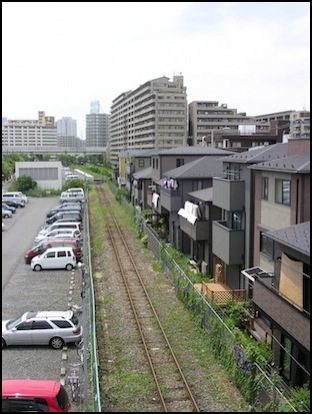

End of the Etchūjima Line, Looking West (left) and East (right) (2009)
Location: Shiohama; Photographer (both): Charles’s Wain
References
Note: much of the above information was derived from machine-translations of Japanese-language sources, and may contain inaccuracies as a result.
Japanese Wikipedia page for Etchujima Branch.
Japanese Wikipedia page for Freight Station Etchūjima.
Japanese Wikipedia page for Onagigawa Station.
Japanese Wikipedia page for Shinkinkamotsusen (Sobu Line freight branch).
Japanese Wikipedia page for Shin-Koiwasou Station. (or possibly Shin-Koiwa Station, it’s unclear)
Japanese Wikipedia page for Wagon Movement Machine (industrial switcher).
and other sources that I forgot to record in my original notes on the line.
Another Japanese-language source with some nice pictures is this one, mentioned above in the description of the Etchūjima Freight Station.




